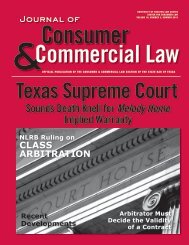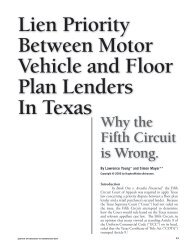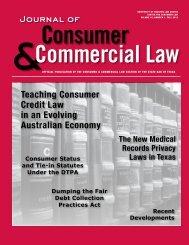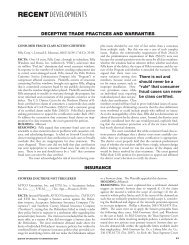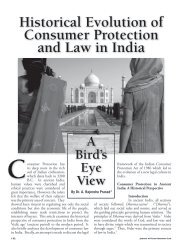Overview of ADR Options at the IRS - Journal of Comsumer ...
Overview of ADR Options at the IRS - Journal of Comsumer ...
Overview of ADR Options at the IRS - Journal of Comsumer ...
You also want an ePaper? Increase the reach of your titles
YUMPU automatically turns print PDFs into web optimized ePapers that Google loves.
<strong>Overview</strong> <strong>of</strong> <strong>ADR</strong><strong>Options</strong> <strong>at</strong> <strong>the</strong> <strong>IRS</strong>By Shannon Thomas * arbitr<strong>at</strong>ion, and use <strong>of</strong> ombuds, or any combin<strong>at</strong>ion <strong>the</strong>re<strong>of</strong>.” 2I. INTRODUCTIONA. <strong>Overview</strong>Altern<strong>at</strong>ive Dispute Resolution is a topic <strong>of</strong> discussionin almost every legal periodical and law school journal, and ismentioned <strong>at</strong> least once in a variety <strong>of</strong> law school courses. Asa result <strong>of</strong> <strong>the</strong> increasing expense and time consumption <strong>of</strong>litig<strong>at</strong>ion, businesses and consumers are looking towards methodso<strong>the</strong>r than litig<strong>at</strong>ion to resolve conflicts. The federal government isno exception and is an example <strong>of</strong> a non-commercial organiz<strong>at</strong>ionfinding a means <strong>of</strong> less costly and less time consuming forms <strong>of</strong>resolving disputes with taxpayers.B. Congressional BackgroundIn 1996, Congress found th<strong>at</strong> administr<strong>at</strong>ive proceedingswere increasingly costly, formal, and lengthy, and th<strong>at</strong> altern<strong>at</strong>ivedispute resolution had worked in <strong>the</strong> priv<strong>at</strong>e sector for many years,yielding faster, cheaper, and less contentious results. 1 Believing th<strong>at</strong>altern<strong>at</strong>ive forms <strong>of</strong> dispute resolution would lead to more cre<strong>at</strong>ive,efficient, and sensible outcomes, Congress sought to implementaltern<strong>at</strong>ive forms <strong>of</strong> dispute resolution in federal agencies. Asoutlined in The Administr<strong>at</strong>ive Dispute Resolution Act <strong>of</strong> 1996,“altern<strong>at</strong>ive means <strong>of</strong> dispute resolution means any procedure th<strong>at</strong>is used to resolve issues in controversy, including, but not limitedto, concili<strong>at</strong>ion, facilit<strong>at</strong>ion, medi<strong>at</strong>ion, fact finding, minitrials,Congress r<strong>at</strong>ionalized th<strong>at</strong> <strong>the</strong> use <strong>of</strong> well-tested dispute resolutiontechniques making altern<strong>at</strong>ive means <strong>of</strong> dispute resolutionavailable would elimin<strong>at</strong>e ambiguity, and enhance <strong>the</strong> oper<strong>at</strong>ion<strong>of</strong> <strong>the</strong> government to better serve <strong>the</strong> public. 3 When setting out toimplement altern<strong>at</strong>ives to litig<strong>at</strong>ion, Congress stressed th<strong>at</strong> “eachagency shall adopt a policy th<strong>at</strong> addresses <strong>the</strong> use <strong>of</strong> altern<strong>at</strong>ivemeans <strong>of</strong> dispute resolution and case management.” 4 Similar too<strong>the</strong>r entities, <strong>the</strong> <strong>IRS</strong> has implemented a number <strong>of</strong> altern<strong>at</strong>ivedispute resolution processes. The altern<strong>at</strong>ive dispute resolutionmethods implemented under <strong>the</strong> <strong>IRS</strong> program are in line with<strong>the</strong> Congressional goals <strong>of</strong> facilit<strong>at</strong>ing formal and informaladjudic<strong>at</strong>ions and enforcement actions.II.<strong>ADR</strong> PROGRAMS AT THE <strong>IRS</strong>A. <strong>Overview</strong>The Internal Revenue Service is organized around three highlevel organiz<strong>at</strong>ions, 1) Commissioner, 2) Services & Enforcement,and 3) Oper<strong>at</strong>ions Support. 5 Reporting to <strong>the</strong> Commissioner are<strong>the</strong> <strong>IRS</strong> Chief Counsel, and <strong>the</strong> Appeals division, among o<strong>the</strong>rgroups and reporting to <strong>the</strong> Services and Enforcement Divisionare four taxpayer divisions, 1) Small Business/Self Employed, 2)Wage and Investment, 3) Large and Mid-Size Business, 4) TaxExempt and Government Entities, and <strong>the</strong> Criminal Investig<strong>at</strong>ion126 <strong>Journal</strong> <strong>of</strong> Consumer & Commercial Law
Division. 6 The divisional <strong>of</strong>fices are responsible for returnsclassific<strong>at</strong>ion, review, field examin<strong>at</strong>ion, <strong>of</strong>fice examin<strong>at</strong>ion andservice. 7 Audit and examin<strong>at</strong>ion <strong>of</strong> returns origin<strong>at</strong>e in one <strong>of</strong> <strong>the</strong>four aforementioned taxpayer divisions, and unresolved issues arereferred to <strong>the</strong> Appeals division. 8The altern<strong>at</strong>ive dispute resolution programs used by <strong>the</strong> <strong>IRS</strong>are flexible in th<strong>at</strong> <strong>the</strong> parties can freely agree to particip<strong>at</strong>e in <strong>the</strong>programs which are deemed best for <strong>the</strong>ir situ<strong>at</strong>ion. Like o<strong>the</strong>rforms <strong>of</strong> <strong>ADR</strong>, <strong>the</strong> <strong>IRS</strong> programs encourage cooper<strong>at</strong>ion among<strong>the</strong> parties, especially in medi<strong>at</strong>ion where <strong>the</strong> parties work witha neutral facilit<strong>at</strong>or to reach a compromised settlement and awin-win outcome. On <strong>the</strong> o<strong>the</strong>r hand <strong>the</strong> parties work againsteach o<strong>the</strong>r in litig<strong>at</strong>ion and <strong>of</strong>ten view <strong>the</strong> process as a win-losesitu<strong>at</strong>ion. The most common forms <strong>of</strong> <strong>ADR</strong> available <strong>at</strong> <strong>the</strong> <strong>IRS</strong>are Early Referral, Fast Track Medi<strong>at</strong>ion, Fast Track Settlement,Post Appeals Medi<strong>at</strong>ionand Arbitr<strong>at</strong>ion.B. Early ReferralEarly Referral is a form <strong>of</strong> altern<strong>at</strong>ive dispute resolution usedby <strong>the</strong> <strong>IRS</strong> to quickly resolve cases with <strong>the</strong> combined efforts <strong>of</strong> <strong>the</strong>District (examin<strong>at</strong>ion or audit <strong>of</strong>fice) and Appeals. 9 For example,if a taxpayer is being audited by <strong>the</strong> <strong>IRS</strong> and a disputed issue ariseswhile <strong>the</strong> audit is being performed,<strong>the</strong> disputed issue can be subject toEarly Referral. The purpose <strong>of</strong> EarlyReferral is to resolve certain issueswhile o<strong>the</strong>r issues are being examined.Early referral is used because <strong>the</strong> <strong>IRS</strong>believes th<strong>at</strong> “early resolution <strong>of</strong> a keyissue may encourage taxpayers and<strong>the</strong> service to agree on o<strong>the</strong>r issuesin <strong>the</strong> case.” 10 Issues th<strong>at</strong> are appropri<strong>at</strong>e for Early Referral arelimited to <strong>the</strong> following:• Issues th<strong>at</strong> if resolved, can reasonably be expected toresult in a quicker resolution <strong>of</strong> <strong>the</strong> entire case;• Issues th<strong>at</strong> both <strong>the</strong> taxpayer and <strong>the</strong> District agreeshould be referred to Appeals early;• Issues th<strong>at</strong> are fully developed; and• Issues th<strong>at</strong> are part <strong>of</strong> a case where <strong>the</strong> remainingissues are not expected to be completed before Appeals couldresolve <strong>the</strong> early referral issue. 11Some issues are excluded from Early Referral because <strong>the</strong>yare counter-productive to <strong>the</strong> very n<strong>at</strong>ure <strong>of</strong> <strong>the</strong> “early” part <strong>of</strong><strong>the</strong> program. For example, if a taxpayer is under audit and has aknown issue for which he and <strong>the</strong> <strong>IRS</strong> examiner are in dispute, itwould not be effective to send th<strong>at</strong> issue to Early Referral if <strong>the</strong>examiner is likely to finalize <strong>the</strong> entire audit in a short period <strong>of</strong>time. Issues excluded from Early Referral are:1. Issues with respect to which a 30-day letter has beenissued;2. Issues th<strong>at</strong> are not fully developed;3. Instances where <strong>the</strong> remaining issues in <strong>the</strong> case areexpected to be completed before Appeals could resolve <strong>the</strong>early referral issue;4. Issues th<strong>at</strong> are design<strong>at</strong>ed for litig<strong>at</strong>ion by <strong>the</strong> Office<strong>of</strong> Chief Counsel;5. Issues for which <strong>the</strong> taxpayer has filed a requestfor Competent Authority assistance or issues for which <strong>the</strong>taxpayer intends to seek Competent Authority assistance; or6. Issues th<strong>at</strong> would subject <strong>the</strong> government toconflicting claims <strong>of</strong> taxpayers. 12Early referral helps to resolve cases more quickly becauseAppeals and <strong>the</strong> examin<strong>at</strong>ion <strong>of</strong>fice usually work simultaneously.Early referrals are initi<strong>at</strong>ed by <strong>the</strong> taxpayer in writing to <strong>the</strong> district<strong>of</strong>fice, and <strong>the</strong> district <strong>of</strong>fice must agree for <strong>the</strong> early referralrequest to be approved. This seems somewh<strong>at</strong> unfair to taxpayers,as this procedure on its face grants unil<strong>at</strong>eral power to <strong>the</strong> district<strong>of</strong>fice to grant or deny a request for early referral, leaving <strong>the</strong>taxpayer with limited options. If an agreement is reached, aclosing st<strong>at</strong>ement will be prepared by Appeals. If Appeals does notagree with <strong>the</strong> taxpayer, Appeals will close <strong>the</strong> Early Referral fileand return it back to <strong>the</strong> district <strong>of</strong>fice jurisdiction; Appeals willnot reconsider an unagreed early referral issue if <strong>the</strong> case is l<strong>at</strong>erprotested to Appeals. However, if <strong>the</strong>re has been a substantialchange in circumstances regarding <strong>the</strong> early referral issue, Appealscan reconsider <strong>the</strong> early referral issue. Although <strong>the</strong>re is n<strong>of</strong>ormal appeal if an early referral request is denied, <strong>the</strong> taxpayermay request a conference with a supervisor <strong>of</strong> <strong>the</strong> examiner whodenied <strong>the</strong> request for early referral, and <strong>the</strong> taxpayer is also freeto pursue o<strong>the</strong>r methods <strong>of</strong> appeal. 13C. Fast Track Medi<strong>at</strong>ionFast Track Medi<strong>at</strong>ion is designed to help Small Business/Self Employed taxpayers. 14 Fast Track Medi<strong>at</strong>ion involves ei<strong>the</strong>ran Appeals <strong>of</strong>ficer or an Appeals team case leader who has beentrained in medi<strong>at</strong>ion techniques. The Appeals personnel act asmedi<strong>at</strong>or between <strong>the</strong> taxpayer and <strong>the</strong> audit team, discussingFast Track Medi<strong>at</strong>ion is available for most issuesth<strong>at</strong> are not docketed in any court, such asdisputes resulting from examin<strong>at</strong>ion, <strong>of</strong>fers incompromise, trust fund recovery penalties ando<strong>the</strong>r collection actions.issues between <strong>the</strong> taxpayer and <strong>the</strong> <strong>IRS</strong>, and possible ways <strong>of</strong>reaching a resolution. The <strong>IRS</strong> has a goal <strong>of</strong> reaching a jointresolution within forty days th<strong>at</strong> is consistent with applicabletax law. Fast Track medi<strong>at</strong>ion is designed for taxpayers whowould prefer to resolve <strong>the</strong>ir disputes in a shorter period <strong>of</strong> time.Reaching a compromised settlement in forty days would save <strong>the</strong>taxpayer time and money which would o<strong>the</strong>rwise be spent onlitig<strong>at</strong>ion. Additionally, because fast track medi<strong>at</strong>ion has a shorttime frame, taxpayers can quickly settle a dispute and move on topersonal and business m<strong>at</strong>ters.Fast Track Medi<strong>at</strong>ion is available for most issues th<strong>at</strong>are not docketed in any court, such as disputes resulting fromexamin<strong>at</strong>ion, <strong>of</strong>fers in compromise, trust fund recovery penaltiesand o<strong>the</strong>r collection actions. Issues th<strong>at</strong> are specifically excludedfrom medi<strong>at</strong>ion are issues with no legal precedent, issues where<strong>the</strong> courts’ decisions differ between jurisdictions, campus andautom<strong>at</strong>ed collection system cases, and cases th<strong>at</strong> involve frivolousarguments. Issues available under Fast Track Medi<strong>at</strong>ion tend tobe those th<strong>at</strong> are factual in n<strong>at</strong>ure.To begin <strong>the</strong> Fast Track Medi<strong>at</strong>ion process, <strong>the</strong> taxpayerand <strong>IRS</strong> represent<strong>at</strong>ive must sign an agreement to medi<strong>at</strong>e, andall relevant decision-makers must be present. Because only anagreement to medi<strong>at</strong>e is being signed initially, <strong>the</strong> taxpayer isnot formally filing a written protest. The taxpayer may representhimself, or may <strong>of</strong>ficially appoint someone to act on his behalf.The <strong>IRS</strong> or <strong>the</strong> taxpayer may withdraw from <strong>the</strong> medi<strong>at</strong>ion <strong>at</strong>anytime, and <strong>the</strong> taxpayer will keep all his appeals rights for thoseissues th<strong>at</strong> were not resolved in <strong>the</strong> medi<strong>at</strong>ion.The goal <strong>of</strong> Fast Track Medi<strong>at</strong>ion is to resolve issues within anaverage <strong>of</strong> 30-40 days. 15 This quick turnaround for resolving issuescan be a selling point for <strong>the</strong> <strong>IRS</strong>. Ano<strong>the</strong>r benefit <strong>of</strong> medi<strong>at</strong>ionis <strong>the</strong> confidential n<strong>at</strong>ure <strong>of</strong> <strong>the</strong> medi<strong>at</strong>ion session. Parties are<strong>of</strong>ten more likely to disclose pertinent inform<strong>at</strong>ion in a medi<strong>at</strong>ionsession if <strong>the</strong>y know <strong>the</strong> inform<strong>at</strong>ion cannot be used against <strong>the</strong>m<strong>Journal</strong> <strong>of</strong> Consumer & Commercial Law 127
adversely in a subsequent legal action. The confidential aspect<strong>of</strong> <strong>the</strong> program is an advantage to those individuals who prefernot to have <strong>the</strong>ir financial affairs made public. With Fast TrackMedi<strong>at</strong>ion, <strong>the</strong> taxpayer retains legal appeals rights and thus, hasvery little to lose by medi<strong>at</strong>ing.B. Fast Track SettlementFast Track Settlement is an <strong>ADR</strong> program for large andmidsize business taxpayers. 16 The purpose <strong>of</strong> <strong>the</strong> program is tohelp taxpayers resolve disputes during an audit examin<strong>at</strong>ion while<strong>the</strong> case is still in <strong>the</strong> compliance area. Fast Track Settlement isalso available for Small Businesses, Self Employed taxpayers ando<strong>the</strong>r taxpayers on a discretionary basis. The program is voluntary,and <strong>the</strong> resolution <strong>of</strong> <strong>the</strong> m<strong>at</strong>ter is not final unless <strong>the</strong> parties agreeto a final resolution. Unlike Fast Track Medi<strong>at</strong>ion, Fast TrackMedi<strong>at</strong>ion can be requested on issues th<strong>at</strong>are unresolved after <strong>the</strong> appeals procedureor after an unsuccessful <strong>at</strong>tempt to enterinto a closing agreement or compromise.Settlement proceedings consider both legal and factual issues.The taxpayer may request Fast Track Settlement after a“Notice <strong>of</strong> Proposed Adjustment” has been issued, and <strong>the</strong> taxpayerprovides a written response. Fast Track Settlement involves anAppeals employee who assists <strong>the</strong> taxpayer and <strong>IRS</strong> represent<strong>at</strong>ivein reaching a resolution <strong>of</strong> disputed issues. The specially trainedAppeals <strong>of</strong>ficer brings Appeals resources to <strong>the</strong> audit site to resolvedisputes before a 30-day letter is issued.Dealing with <strong>the</strong> <strong>IRS</strong> over various issues can becomeexpensive for business taxpayers due to <strong>the</strong> length <strong>of</strong> time it takes<strong>the</strong> <strong>IRS</strong> to process and review issues. Fast Track Settlement is aquick altern<strong>at</strong>ive <strong>of</strong> resolving disputes, allowing time for taxpayersto focus on <strong>the</strong>ir commercial oper<strong>at</strong>ions. Benefits touted by <strong>the</strong><strong>IRS</strong> for Fast Track Settlement are:• A one page applic<strong>at</strong>ion;• Consider<strong>at</strong>ion <strong>of</strong> <strong>the</strong> hazards <strong>of</strong> litig<strong>at</strong>ion;• An answer within 120 days;• No “hot” interest under Internal Revenue Code § 6621;• Taxpayer may withdraw from <strong>the</strong> process <strong>at</strong> any time;• Taxpayer retain all traditional appeal rights;• Significantly shortens <strong>the</strong> taxpayer’s <strong>IRS</strong> experience;• Involves only one tax comput<strong>at</strong>ion;• The Taxpayer’s case closes agreed in Compliance; and• Immedi<strong>at</strong>e use <strong>of</strong> Deleg<strong>at</strong>ion Order 236. 17Similar to Fast Track Medi<strong>at</strong>ion, Fast Track Settlement mustbe approved by <strong>the</strong> Appeals <strong>of</strong>fice. This is ano<strong>the</strong>r example <strong>of</strong> <strong>the</strong>unil<strong>at</strong>eral power <strong>of</strong> <strong>the</strong> Appeals <strong>of</strong>fice in resolving taxpayer issuesthrough altern<strong>at</strong>ive forms <strong>of</strong> dispute resolution. If an agreementis not reached through Fast Track Settlement, <strong>the</strong> taxpayer retainshis traditional his right to appeal.C. Post Appeals Medi<strong>at</strong>ionPost Appeals Medi<strong>at</strong>ion can be requested on issues th<strong>at</strong> areunresolved after <strong>the</strong> appeals procedure or after an unsuccessful<strong>at</strong>tempt to enter into a closing agreement or compromise. Anadditional requirement <strong>of</strong> medi<strong>at</strong>ion is th<strong>at</strong> <strong>the</strong> taxpayer’s casecannot be docketed in any court. Post Appeals Medi<strong>at</strong>ion with<strong>the</strong> <strong>IRS</strong> involves a medi<strong>at</strong>or jointly selected by <strong>the</strong> taxpayerand <strong>the</strong> <strong>IRS</strong> to serve as a facilit<strong>at</strong>or, helping <strong>the</strong> parties reach anegoti<strong>at</strong>ed settlement. Post Appeals Medi<strong>at</strong>ion should be limitedto issues th<strong>at</strong> are factual in n<strong>at</strong>ure, although certain legal issuesmay be handled under medi<strong>at</strong>ion. The medi<strong>at</strong>ors can come from<strong>the</strong> Appeals division, or <strong>the</strong> taxpayer can select his own medi<strong>at</strong>or<strong>at</strong> his own expense.Similar to o<strong>the</strong>r medi<strong>at</strong>ion situ<strong>at</strong>ions, <strong>IRS</strong> medi<strong>at</strong>ors donot have <strong>the</strong> authority to order a settlement, but <strong>the</strong> partiesmay contractually agree to irrevocably resolve <strong>the</strong> dispute. Withmedi<strong>at</strong>ion as <strong>the</strong> chosen method <strong>of</strong> dispute resolution, <strong>the</strong> entireprocess can be completed within 90 to 120 days. If <strong>the</strong> medi<strong>at</strong>oris selected from <strong>the</strong> Appeals <strong>of</strong>fice, <strong>the</strong> Appeals n<strong>at</strong>ional <strong>of</strong>ficewill assume all <strong>of</strong> <strong>the</strong> medi<strong>at</strong>or’s expenses. A taxpayer-selectedmedi<strong>at</strong>or can come from any local or n<strong>at</strong>ional organiz<strong>at</strong>ion th<strong>at</strong>provides a list <strong>of</strong> neutral parties acting as medi<strong>at</strong>ors, and mostmedi<strong>at</strong>ion sessions are concluded in one day. If needed, however,<strong>the</strong> parties can schedule two additional medi<strong>at</strong>ion sessions.Issues specifically excluded from Post Appeals Medi<strong>at</strong>ionare certain collection issues, issues th<strong>at</strong> are not consistent withsound tax administr<strong>at</strong>ion, frivolous arguments,and issues where <strong>the</strong> taxpayer did not act ingood faith during <strong>the</strong> settlement negoti<strong>at</strong>ions.D. Arbitr<strong>at</strong>ionBinding Arbitr<strong>at</strong>ion is ano<strong>the</strong>r option availablefrom <strong>the</strong> <strong>IRS</strong>, and may be requested forfactual issues th<strong>at</strong> are already in <strong>the</strong> Appealsadministr<strong>at</strong>ive process, or after unsuccessful <strong>at</strong>tempts to enterinto a closing agreement under Internal Revenue Code § 7121. 18Arbitr<strong>at</strong>ion is not available for cases th<strong>at</strong> involve Compliance andAppeals coordin<strong>at</strong>ed issues, legal issues, certain collection issues,issues th<strong>at</strong> are not consistent with sound tax administr<strong>at</strong>ion,frivolous arguments and those where <strong>the</strong> taxpayer did not act ingood faith during settlement negoti<strong>at</strong>ions.The Arbitr<strong>at</strong>ion program uses a neutral decision-makerwho reaches a binding decision on issues th<strong>at</strong> prevented <strong>the</strong>taxpayer and <strong>the</strong> Appeals division from reaching an agreement.Arbitr<strong>at</strong>ion is a useful option in situ<strong>at</strong>ions where an arbitr<strong>at</strong>or’sexperience can be used to give <strong>the</strong> taxpayer a more favorableexperience and outcome. 19 The parties must agree to arbitr<strong>at</strong>ionby filing a motion with <strong>the</strong> court before trial, and a provisionmust be <strong>at</strong>tached with <strong>the</strong> issues to be resolved, and <strong>the</strong> parties’agreement to be bound by <strong>the</strong> arbitr<strong>at</strong>or’s decisions. Additionally,<strong>the</strong> document must contain <strong>the</strong> identity <strong>of</strong> <strong>the</strong> arbitr<strong>at</strong>or, <strong>the</strong>arbitr<strong>at</strong>or’s compens<strong>at</strong>ion and how <strong>the</strong> parties will split <strong>the</strong> cost,as well as a prohibition against ex parte communic<strong>at</strong>ion with <strong>the</strong>arbitr<strong>at</strong>or.The design<strong>at</strong>ion <strong>of</strong> an arbitr<strong>at</strong>or may be conducted within<strong>the</strong> <strong>IRS</strong> or from an outside source. An <strong>IRS</strong> represent<strong>at</strong>ive whoserves as an arbitr<strong>at</strong>or must be taken from ano<strong>the</strong>r appeals regionor serve <strong>at</strong> <strong>the</strong> n<strong>at</strong>ional <strong>of</strong>fice. The motion for binding arbitr<strong>at</strong>ion“may be made before trial <strong>at</strong> any time after <strong>the</strong> case is <strong>at</strong> issue.” 20Although arbitr<strong>at</strong>ion is a more formal process than <strong>the</strong> o<strong>the</strong>rforms <strong>of</strong> altern<strong>at</strong>ive dispute resolution techniques, it does haveadvantages over litig<strong>at</strong>ion. Arbitr<strong>at</strong>ion provides a relaxed set <strong>of</strong>rules <strong>of</strong> evidence and a relaxed adversarial setting, which maybe beneficial to those taxpayers who lack represent<strong>at</strong>ion or legalexpertise. 21 One benefit <strong>of</strong> arbitr<strong>at</strong>ion is th<strong>at</strong> The Administr<strong>at</strong>iveDispute Resolution Act <strong>of</strong> 1996 allows for “arbitr<strong>at</strong>ion on <strong>the</strong>condition th<strong>at</strong> <strong>the</strong> award must be within a range <strong>of</strong> possibleoutcomes.” 22 Although this does not guarantee a definite outcome,it could induce a party to arbitr<strong>at</strong>e knowing th<strong>at</strong> <strong>the</strong> eventualoutcome is one <strong>of</strong> several possible th<strong>at</strong> had been previouslydiscussed.III. ConclusionCongress has recognized a need to improve and expedite its<strong>the</strong> dispute resolution system. The <strong>IRS</strong>, under <strong>the</strong> direction <strong>of</strong>Congress, has implemented a number <strong>of</strong> programs for varying128 <strong>Journal</strong> <strong>of</strong> Consumer & Commercial Law
taxpayers and issues. It is important for taxpayers to take advantage<strong>of</strong> <strong>the</strong> programs early in <strong>the</strong> dispute resolution process to preventproblems such as a lapse in <strong>the</strong> st<strong>at</strong>ute <strong>of</strong> limit<strong>at</strong>ions. Some <strong>of</strong> <strong>the</strong>advantages for using <strong>ADR</strong> <strong>at</strong> <strong>the</strong> <strong>IRS</strong> are:• It provides a different avenue <strong>of</strong> resolving disputes when anagreement can not be reached between with <strong>the</strong> taxpayerand <strong>the</strong> examiner;• The taxpayer becomes a person, not a number, because <strong>the</strong>meetings and proceedings are informal;• Even in situ<strong>at</strong>ions where <strong>the</strong> altern<strong>at</strong>ive dispute resolutionmechanisms do not work for <strong>the</strong> parties, <strong>the</strong>y havea rel<strong>at</strong>ionship which may prove valuable in futureproceedings;• The proceedings <strong>of</strong>fer confidentiality for those parties whoprefer not to have a public trial or for <strong>the</strong>ir inform<strong>at</strong>ion tobe made public.While <strong>the</strong> <strong>ADR</strong> programs <strong>at</strong> <strong>the</strong> <strong>IRS</strong> have <strong>the</strong>ir advantages,<strong>the</strong>y also have disadvantages. Some issues will not be resolvedthrough medi<strong>at</strong>ion so th<strong>at</strong> a precedent can be set. There aresome instances when litig<strong>at</strong>ing a dispute in <strong>the</strong> court systemwould be quicker and cheaper than using <strong>ADR</strong>. Despite <strong>the</strong>possible disadvantages, however, <strong>the</strong> altern<strong>at</strong>ive dispute resolutionprograms <strong>at</strong> <strong>the</strong> <strong>IRS</strong> seem to be effective. According to <strong>the</strong> Office<strong>of</strong> <strong>the</strong> N<strong>at</strong>ional Director <strong>of</strong> Appeals:• 84% <strong>of</strong> respondents said <strong>the</strong>y would use Appeals again;• 70% were completely or somewh<strong>at</strong> s<strong>at</strong>isfied with Appealsfairness and impartiality; and• 70% were completely or somewh<strong>at</strong> s<strong>at</strong>isfied with <strong>the</strong> overallAppeals process. 23Based on <strong>the</strong>se st<strong>at</strong>istics, it seems as though altern<strong>at</strong>ive disputeresolution will continue to be a part <strong>of</strong> <strong>the</strong> Internal RevenueService. It has gained acceptance in <strong>the</strong> early stages, and withtime and improvement, it may eventually reduce or elimin<strong>at</strong>e <strong>the</strong>need for litig<strong>at</strong>ion <strong>of</strong> tax issues.For more inform<strong>at</strong>ion about <strong>ADR</strong> <strong>at</strong> <strong>the</strong> <strong>IRS</strong>, visit itswebsite, www.irs.gov (keyword “appeals”).*Shannon Thomas is a third year law student <strong>at</strong> <strong>the</strong> University <strong>of</strong>Houston Law Center. She received her J.D. in May 2007.1. The Administr<strong>at</strong>ive Dispute Resolution Act <strong>of</strong> 1996, Pub. L.No. 104-320, § 2.2. 5 U.S.C.A. § 571 (1996).3. The Administr<strong>at</strong>ive Dispute Resolution Act <strong>of</strong> 1996, Pub. L.No. 104-320, § 2.4. Id. <strong>at</strong> § 3.5. Saltzman, Michael, <strong>IRS</strong> Practice and Procedure, §8.02, 1999WL 1050935, also available <strong>at</strong> http://www.irs.gov/irs/article/0,,id=149197,00.html (last accessed Apr. 18 2007).6. Id; see also http://www.irs.gov/irs/article/0,,id=149199,00.html(last accessed Apr. 18 2007).7. Id.8. Id.9. Rev. Proc. 99-28, 1999-29 I.R.B. 109.10. Internal Revenue Service, Department <strong>of</strong> Treasury, Public<strong>at</strong>ion4167, Appeals, (2005).11. Id.12. Id.13. Id.14. Rev. Proc. 2003-41, 2003-25 I.R.B. 1047.15. Id.16. Rev. Proc. 2003-40, 2003-25 I.R.B. 1044.17. Id.18. Rev. Proc. 2006-44, 2006-44 I.R.B. 800.19. John M. Beehler, <strong>IRS</strong> Altern<strong>at</strong>ive Dispute Resolution Initi<strong>at</strong>ives,THE TAX ADVISOR (Feb. 2000).20. Id.21. Gregory P. M<strong>at</strong><strong>the</strong>ws, Using Negoti<strong>at</strong>ion, Medi<strong>at</strong>ion, andArbitr<strong>at</strong>ion to Resolve <strong>IRS</strong>-Taxpayer Disputes, 19 OHIO ST. J. ONDISP RESOL. 709, 722 (2004).22. The Administr<strong>at</strong>ive Dispute Resolution Act <strong>of</strong> 1996, Pub. L.No. 104-320, 5 U.S.C. §575.23. Thomas C. Louthan, How to Handle a Tax controversy <strong>at</strong> <strong>the</strong>Restructured <strong>IRS</strong> and in Court, SG063 A.L.I.-A.B.A. 245 (2002).<strong>Journal</strong> <strong>of</strong> Consumer & Commercial Law 129



